
35 minute read
their comparison
4.2 Basic characteristics of the dual system of education and training in selected countries of the European
Union and their comparison1
Advertisement
Germany (2016)
In Germany, the dual system of education and training has a long tradition, its modern form has been developing since the 1920s. It is regulated by the Vocational Training Act from 1969, which provides a general framework for later more detailed legislative elaboration. This law focuses on a part of the training provided at the workplace. Education in secondary vocational schools is not regulated at the federal level, it is addressed at the level of school laws of 16 federal states. In 2015, up to 70% of all secondary vocational school students were trained in the dual system of education and training in Germany, which is almost 40% of all secondary school students, even though vocational education can be obtained outside the dual system of education and training.
Apprenticeship education within the dual system of education and training is implemented at the upper level of secondary education lasting 2–3 years, partly in the workplace and partly in a secondary vocational school, while their alternation is not precisely defi ned, it depends on the particular school. It can take place on certain days of the week, or at intervals, taking into account the needs of stakeholders and the region. Compulsory teaching in a secondary vocational school is 12 teaching hours (on average), of which 8 hours should be devoted to a vocational subject.
Education within the dual system of education and training is intended for students after the end of compulsory schooling, while the age limits are not strictly defi ned. Employers and apprentices are bound by a contractual relationship in accordance with the Labour Code (this is an employment relationship, i.e. the apprentice is offi cially in the position of an employee and there is no contractual relationship between the employer and the secondary vocational school) and preparation for work activities is in accordance with the professional profi le, which is based on the offi cial workplace training curriculum. The share of school education and on-the-job training is not legally defi ned, but depending on the curriculum, the time spent at the workplace amounts to approximately 70% of the total
1 Compiled based on up-to-date data published in Cedefop’s European database on apprenticeship systems (2019).
study time. The costs associated with on-the-job training are covered by the employer, while training in secondary vocational schools is fi nanced by the state. Apprentices receive a salary that is subject to taxation for their work.
The standard length of education in the dual system of education and training in Germany is 36–42 months, depending on the profession. If the student successfully passed the school-leaving examination in the past, the duration of the program can be shortened by 1 year. 2-year programs have been created for students for whom standard education in this system could be too demanding (approximately 8% of all students involved in the dual system of education and training).
After successful completion of the fi nal exam, graduates acquire professional qualifi cations and become qualifi ed workers.
In Germany, the dual system of education and training is also used in post-secondary education.
Figure1 The system of education in Germany (Eurydice, 2019 – https://eacea.ec.europa.eu/ national-policies/ eurydice/content/germany_en)
Austria (2019)
Same as in Germany, apprenticeship training has a tradition of several years in Austria. The dual system of education and training is regulated by the 1969 Law - Federal Apprenticeship Training Act. It defi nes an apprentice as a person who is professionally educated and at the same time is employed on the basis of an apprenticeship contract. He is preparing for a profession at an authorized workplace. If
the student is unable to fi nd a workplace, he can participate in the so-called intercompany training (Überbetriebliche Ausbildung) in the workshops of the training centres. The dual system of education and training in Austria takes place at the upper secondary level from 2 to 4 years, depending on the specifi c profession. It is intended for students from the age of 14. Approximately 60% of students enter the dual system of education and training when they are 15–16. In Austria, up to 80% of students are educated in secondary vocational schools, of which about half are in apprenticeships. The alternation of vocational training at school and in the workplace can take place in 3 ways: • all year round - at least one full or 2 half days a week spent at the workplace; • block - at least 8 consecutive weeks; or • seasonal - block in a specifi c part of the year.
Up to 75% - 85% of the time is spent by apprentices in preparation for a profession at the workplace, in connection with which all costs are stood by the employer. At the same time, the apprentice receives a wage from the employer for the work performed, which is the subject to taxation. According to the Labour Code, the employer and the apprentice enter into a contract between themselves, which is signed by his legal representative if the apprentice is a minor. The apprenticeship contract includes requirements related to both the employment relationship and the practical training for the profession. The theoretical part of vocational training and general education subjects in secondary vocational schools is fi nanced by the state. Accredited providers are supported by the state in the form of subsidies, tax and levy relief, etc. Graduates receive an apprenticeship certifi cate. It is interesting that in Austria it is not possible to obtain an apprenticeship certifi cate by any other (“non-dual”) form of education.
Figure 2 The system of education in Austria (Eurydice, 2019 – https://eacea.ec.europa.eu/national -policies/ eurydice/content/austria_en)
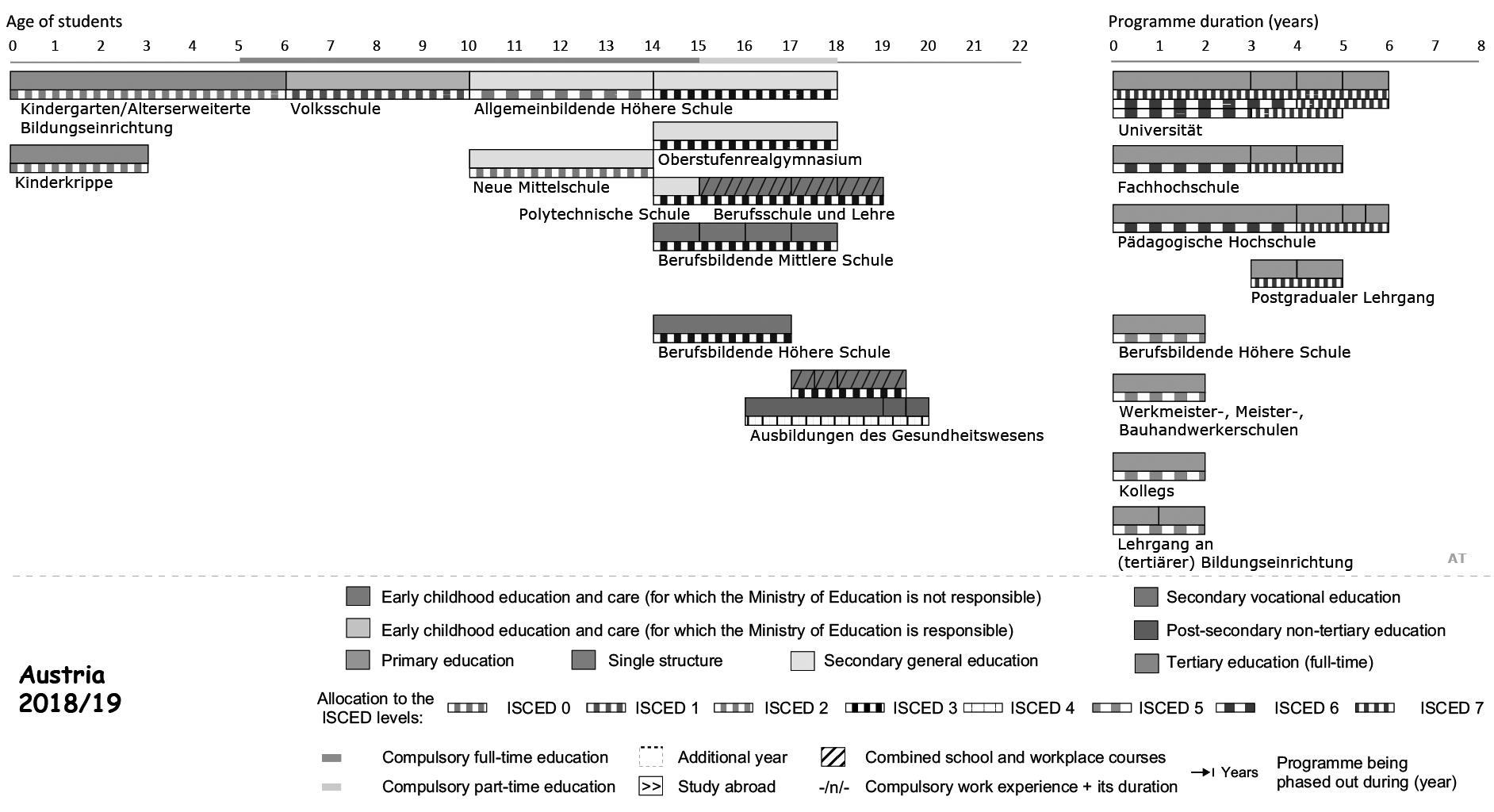
Denmark (2016)
Apprenticeship in Denmark (as in other countries) appeared in the Middle Ages. Currently, less than 20% of students who have completed compulsory schooling are involved in this form of education. By comparison, approximately 75% of this population chooses general secondary education.
The Danish Vocational Training Act defi nes vocational training as based only on alternating vocational training at school and in the workplace. It is implemented through apprenticeships (lærlingeuddannelser) within upper secondary education. After completing 40 weeks of education at a secondary vocational school (grundforløbet), apprentices choose a suitable program for them and sign a contract with the workplace where the apprentice becomes an employee with a special status, because the employer is responsible for his vocational training. The apprenticeship contract is approved by the school, which is not a contracting party. Students who are unable to conclude an apprenticeship contract can take part in practical training in school centres of professional practice (skolepraktikcentre).
After completing the initial 40 weeks, education at school and in the workplace is usually carried out in blocks, in a ratio of 1: 4, although there is no legal regulation for this ratio. Blocks alternate at the workplace (max. 1 year) and school (max. 3 months).
The standard length of secondary vocational education is 4 years. In some cases, there are also 3-year and 5-year programmes. For students who are unable to cope with the demands of traditional vocational education, they have created 2-year programs in, which are also based on alternating vocational training at school and in the workplace.
Apprenticeship education is intended for graduates of the 9th and 10th grade of education (lower secondary education), which corresponds to the age of 16–17 years. However, most applicants enter the program later. Their average age at entry into the vocational education system is 21 years. In the case of adult applicants, their previous education is taken into account and the length of study may be shortened.
The costs associated with employing apprentices are covered by the employer, but in Denmark, all organizations that employ at least 5 employees need to contribute to the fund, regardless of whether they employ apprentices. These funds are used to compensate employers for costs related to the training of apprentices - e.g. their wages. Apprentices who want to complete part of the training abroad are also supported by this fund.
Figure 3 The system of education in Denmark (Eurydice, 2019 – https://eacea.ec.europa.eu/national-policies/ eurydice/content/denmark_en)
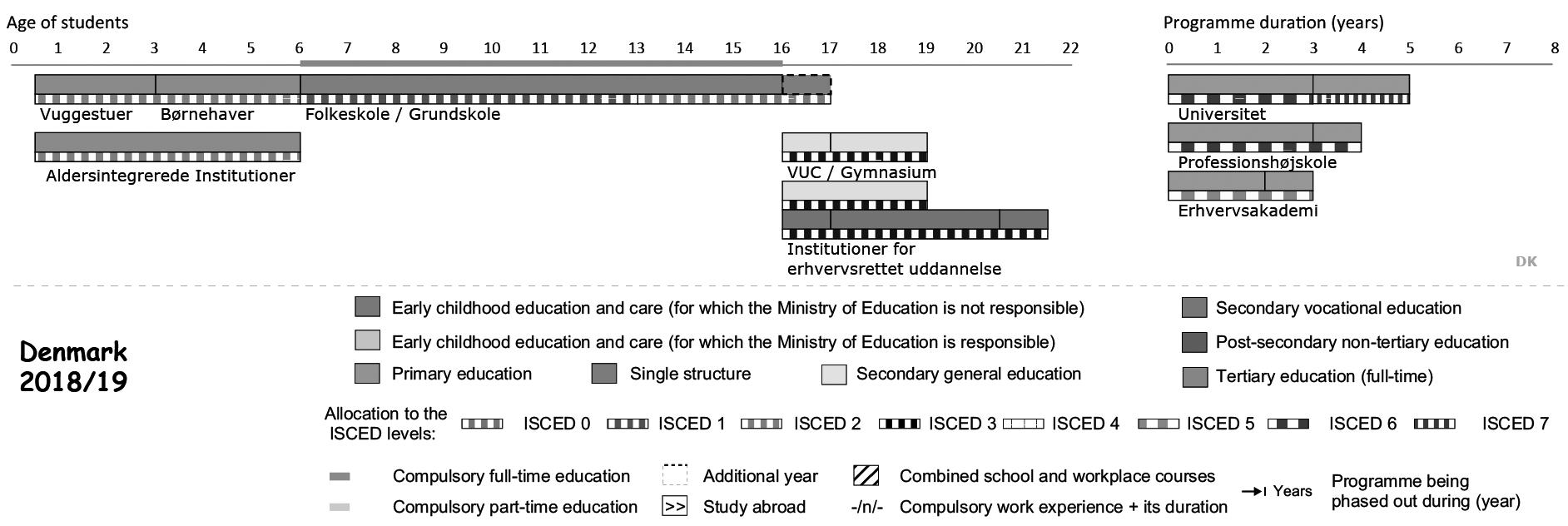
United Kingdom (2016)
The history of apprenticeships in the United Kingdom dates back to the Middle Ages, although the intensity and form of its support for the state changed over time. While in the 90s of the 20th century it was not supported at all, the current stakeholders are paying increased attention to it and eff orts are being directed towards its rapid development. In the United Kingdom, apprentices are considered full-time employees (i.e. not students) with combined on-the-job and off -thejob training. An apprentice who successfully completes education and
training will gain a nationally recognized qualifi cation. Apprentices have the same rights as other employees in the organization and are paid.
In England, Wales and Northern Ireland, apprenticeships take place at secondary (Apprenticeship) and post-secondary (Higher Apprenticeship) levels. In Scotland, the so-called Modern Apprenticeship, which combines secondary and post-secondary education. Although apprenticeship is funding by the government, there are several diff erences between England, Wales, Scotland and Northern Ireland.
England, Wales and Northern Ireland
Apprenticeship education in England is primarily aimed at young people aged from 16 to 24 but is also open to older people and the unemployed. It is generally considered to be the main way of vocational education and training and it is also fi nancially supported by the government. Over time, interest has shifted from crafts to the current fastest growing sectors of the economy, such as selling, trading or working with IT. In 2011, the greatest interest was in the customer service department. The standard length of education is 12 months in the range of min. 30 hours per week, but for apprentices over the age of 19, it may only take 6 months depending on specifi c circumstances and experience. At least 280 hours in the workplace needs to be devoted to training, where apprentices’ technical skills, theoretical knowledge and practical skills are developed. Outside the workplace, the apprentice needs to complete 100 hours or 30% of the entire training program. An apprenticeship contract is concluded between the employee (apprentice) and the employer. The apprentice’s salary is paid by the employer.
Figure 4 The system of education in England (Eurydice, 2019 – https://eacea.ec.europa.eu/national -policies/ eurydice/content/united-kingdom-england_en)

Figure 5 The system of education in Wales (Eurydice, 2019 – https://eacea.ec.europa.eu/national -policies/ eurydice/content/united-kingdom-wales_en)

Figure 6 The system of education in Wales (Eurydice, 2019 – https://eacea.ec.europa.eu/national -policies/ eurydice/content/united-kingdom-northern-ireland_en)

Scotland
In Scotland, a system of ‘modern apprenticeship’ was introduced in 1990. Initially, it focused on manual professions such as mason or repairer, but in the 2012/2013 school year, it was already training for 70 diff erent professions. This system, which is the main (but not the only) way leading to the acquisition of professional qualifi cation of various degrees, is entered by students after the end of compulsory schooling, i.e. at the age of 16. It was originally intended for young people aged 16–24, but the upper age limit has been removed.
All apprentices need to have an employment relationship. The peculiarity is that in this system the parties are not bound by the apprenticeship contract. On-the-job training is funded by the employer but he
receives a contribution from the state. Apprentices receive an hourly wage, which is subject to taxation.
The duration of education is not given, depending on the profession and other conditions, it can take from a few months to 4 years.
Figure 7 The system of education in Scotland (Eurydice, 2019 – https://eacea.ec.europa.eu/national-policies/ eurydice/content/united-kingdom-scotland_en)
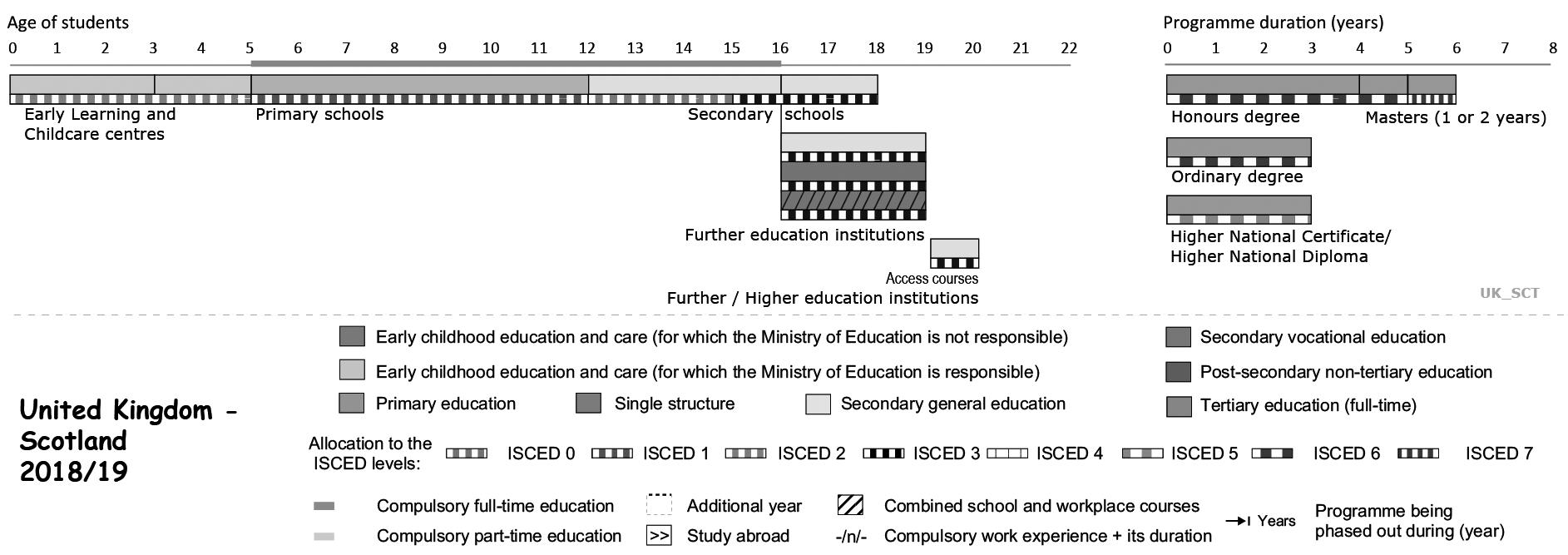
Ireland (2016)
The history of apprenticeships in Ireland dates back to the Middle Ages, and in the past, it was carried out exclusively in the workplace. This type of education was legally regulated in 1898. In 1930 and 1931, laws on vocational education and training of apprentices were passed. Its current adaptation is from 1967 and 1997. In the Irish education system, apprenticeships are defi ned as a structured vocational education and training program that formally combines and alternates learning in the workplace and an educational institution. It is a dual system of education and training, after which the student is prepared to perform a certain profession and obtains a nationally recognized qualifi cation. For the duration of the education (at least 2 years), the student gets an apprenticeship contract. On-the-job training accounts for more than 50% of total training time. This form of a professional qualifi cation is one of the options off ered in Ireland, its duration is 2–4 years. The educational program consists of 7 phases, which alternate – 3 at school and 4 at work. Approximately 65% of the total duration of training takes place for the employer. On-the-job training takes place based on an apprenticeship contract, with the apprentice being both a student and an employee. He receives a fi nancial reward for his work, which is not subject to taxation.
The basic requirement for this type of study is reaching the age of 16 and obtaining a Junior Certifi cate. Under certain circumstances,
apprentices who do not meet these requirements may also be registered with the employer. Although such education is aimed primarily for young people, there is no upper age limit.
On-the-job training is partly paid by the employer and partly by the state. The employer receives tax relief and subsidies from the state.
Figure 8 The system of education in Ireland (Eurydice, 2019 – https://eacea.ec.europa.eu/national-policies/ eurydice/content/ireland_en)
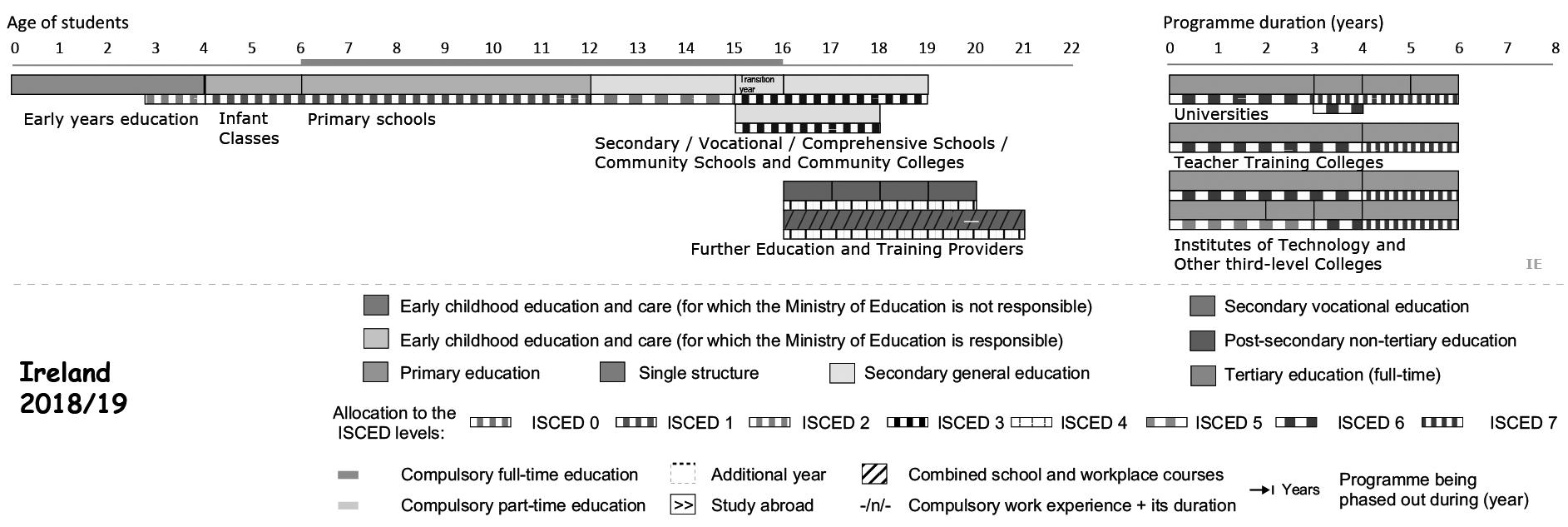
Portugal (2016)
After 1974, there were strict restrictions on vocational training in Portugal, and it did not begin to develop again until the late 1980s. Since 2000, several of its reforms have taken place to increase the interest of applicants for this type of study, based on the fact that it is linked to the real requirements and needs of the labour market, and also the needs of the student. In Portugal, employer training takes place at the upper secondary and post-secondary level for an average of 2.5 years and is one of the alternative ways of obtaining a professional qualifi cation. It has been running in its current form since the school year 2005/2006. We talk about a group consists of young people aged 15–24 who have not completed upper secondary education.
On-the-job training accounts for approximately 40% of the entire training program and is carried out based on an apprenticeship contract. The form of alternating education at school and training in the workplace is not strictly given. Apprentices do not receive a salary for their work but may be awarded a scholarship from the ESF. They can also receive allowances for accommodation, traveling, meals, etc.
While in the school year 2005/2006 35% of all secondary vocational school students were educated in this way, in the school year 2012/2013 it was only 22%, which is approximately 9% of all
secondary school students. The costs of education are covered by the social security fund and EU funds.
Figure 9 The system of education in Portugal (Eurydice, 2019 – https://eacea.ec.europa.eu/ national-policies/ eurydice/content/portugal_en)

Belgium (2016, 2019)
Walloon Region (2019)
In 1907, the fi rst apprenticeship offi ce was established in the Walloon Region of Belgium. The current system of dual system of education and training has been in force since 1985 when compulsory schooling was extended to the age of 18. It was to serve as a prevention of early school leaving.
Apprenticeship training in the Walloon Region of Belgium needs to meet 6 characteristics: 1. education takes place at school and at the workplace, fulfi lling one plan in a coordinated way, 2. the educational program leads to the acquisition of a professional qualifi cation, 3. on-the-job training is on average 20 hours per week (calculated for the whole year without holidays), 4. the theoretical part of education is realized in the range of 240 hours for compulsory school youth and 150 hours for students after the end of compulsory school attendance, 5. students, school and employer are contractually bound, 6. the student receives a reward from the employer for his / her work.
Apprenticeship education implemented at the upper secondary level is intended for students aged 15–25. Most students are over the age of 18, which may be justifi ed by the fact that most students in the dual system of education and training have already failed some form of study. Education is carried out in the range of 38 hours per week, of which 20 hours are completed by the student at the workplace - the standard is 1–2 days a week at school and 3–4 days at the workplace. The study plan needs to be attached to the apprenticeship contract. The dual system of education and training is funded by the state, and employers also receive relief from tax and contribution obligations. Besides, employers can receive subsidies for apprentices. Apprentices receive a taxable wage from their employer for their work. In the French-speaking part of Belgium, approximately 48% of all students in upper secondary education study in secondary vocational schools, compared to 6.4% in the dual system of education and training. 13% of all secondary vocational school students are involved in the dual system of education and training.
Figure 10 The system of education in Belgium - Walloon Region (Eurydice, 2019 – https://eacea.ec.europa.eu/national-policies/eurydice/content/belgium-french-community_ en)

Flemish Region
In the Flemish part of Belgium, the dual system of education and training is part of secondary vocational education as one of the options, it is implemented in two forms. In the fi rst case, it is an alternation of 2 days a week spent at school and 3 days at the employer, where the student is employed part-time. The second option combines 1 day a week of theoretical teaching at school and 4 days of on-the-job training.
In its current form, dual system of education and training has been implemented since 2008, but the transformation of the existing linear
model into a modular model is currently underway to prevent early school leaving and so that the student can complete another module with a certain time lag. Apprenticeship training in Belgium is mainly aimed at disadvantaged students.
The fi rst form of dual system of education and training, the standard duration of which is 3 years, is entered by students aged 15–25 after the end of lower secondary education, but they are often those who repeated a year or more in the past or they left school earlier, therefore it is a relatively small part of the population of secondary vocational school students. On-the-job training, which accounts for less than 50% of total training time, is carried out based on a parttime employment contract between a student and an employer and is funded by an employer who is provided with tax and levy relief and receives subsidies. The apprentice receives a salary for the done work. The second option of completing a dual education program is apprenticeship training for small and medium-sized enterprises, which is based on the traditional master-apprentice relationship. It is implemented based on an apprenticeship contract. The majority of education takes place in the workplace. Apprentices receive remuneration from the employer, which is lower than the average wage in the given fi eld.
Figure 11 The system of education in Belgium - Flemish Region (Eurydice, 2019 https://eacea.ec.europa.eu/national-policies/eurydice/content/belgium-fl emish-community_ en)

Finland (2016)
Apprenticeship education in Finland has a tradition of almost a century – it was fi rst enshrined in legislation in 1923. It is defi ned as practical on-the-job learning supplemented by theoretical studies.
It is implemented based on an apprenticeship contract on temporary employment. The student, employer and school enter into a contractual relationship. The apprentice has the status of a student and at the same time an employee. Organizations involved in the dual system of education and training can apply for a contribution/compensation for the costs of providing training.
After completing primary school, about half of the students start studying in secondary vocational schools, but not in apprenticeship programs. Also in other forms of secondary vocational education, a large part of the program is devoted to practical training, but it is not based on an apprenticeship contract and salaries are not paid to students (in the case of apprentices it needs to reach at least the minimum wage). Most apprentices are over 18 years old, although the lower age limit is 15 years. Less than 20% of all secondary vocational school students are involved in the dual system of education and training, which is about 4%–5% of the entire population of secondary school students.
The dual system of education and training is implemented at the upper secondary level within a 3-year program, in the form of further education or within education through practical training, which, however, does not lead to the acquisition of a qualifi cation. On-thejob training makes up 70%–80% of the training program and usually alternates between one or more weeks of blocks at school and in the workplace.
Figure 12 System of education in Finland (Eurydice, 2019 – https://eacea.ec.europa.eu/national -policies/ eurydice/content/fi nland_en)

France (2016)
In France, the dual system of education and training is one of the off ered alternatives. It is based on two types of contracts - an apprenticeship contract or a professionalization contract, which are signed by the apprentice or his legal representative and employer. Apprenticeship contracts have been in use since 1919. Professionalization contracts have a much shorter history, they were introduced in 2004 and were set up to reduce unemployment of the population. The French government aims to increase the number of students in the dual system of education and training, so in 2015 the apprenticeship was reformed.
Education-based on an apprenticeship contract is intended primarily for young people aged from 16 to 25, but there is no upper age limit, adults can also take part in it. It takes the form of an alternation of theoretical education in training centres and vocational training in the workplace. It normally lasts 3 years, but the apprenticeship contract can, depend on the study, and can be concluded for a period of 1–3 years, in exceptional cases also for 6 months.
An apprentice may have one or more employers. On-the-job training takes about 20%–25% of total training time. The cost of the training is paid by the employer, who pays the apprentices a salary. The employer receives a contribution from the region and has a tax relief from the state.
The dual system of education and training is implemented at the secondary level, but also within higher education.
Figure 13 The system of education in France (Eurydice 2019 – https://eacea.ec.europa.eu/ national-policies/ eurydice/content/france_en)
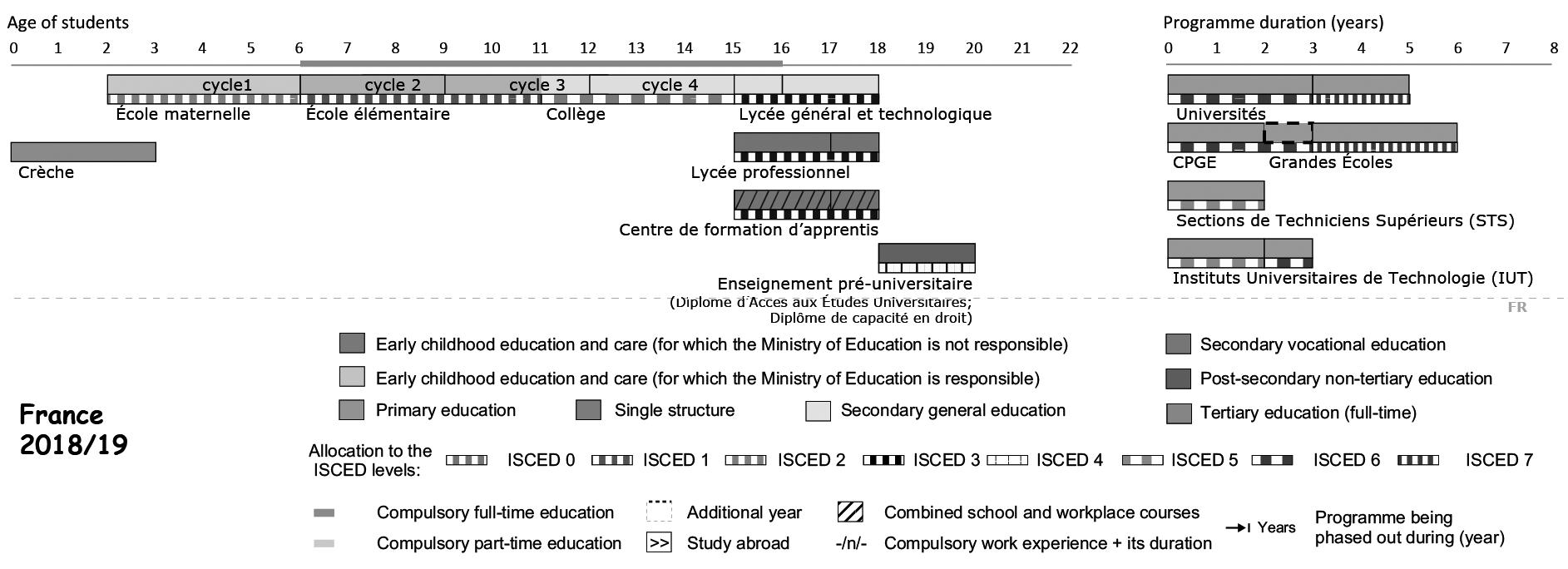
Netherlands (2016)
The dual system of education and training in the Netherlands takes place at the upper secondary level for 1 to 4 years. It represents an alternative to the school form of vocational education, where the short-term practice is also a part of it. It was introduced in its current form in 1995. The apprenticeship contract is concluded between the student, the employer and the school.
In the Netherlands, the completion of dual system of education and training leads to the acquisition of professional qualifi cation. Students start this form of study after completing lower secondary education, it is chosen by approximately 25% of all students in secondary vocational education, which is less than 10% of the entire population. During one school year, the student needs to complete 850 hours of education, of which at least 200 must be theoretical teaching at school and at least 610 hours need to be completed at the workplace. By default, students are educated at school one day a week and spend four days a week at work.
The employer pays the apprentice a salary, as well as all costs associated with on-the-job training. The state provides subsidies to employers.
Figure 13 The system of education in the Netherlands (Eurydice 2019 – https://eacea.ec.europa.eu/ national-policies/ eurydice/content/netherlands_en)
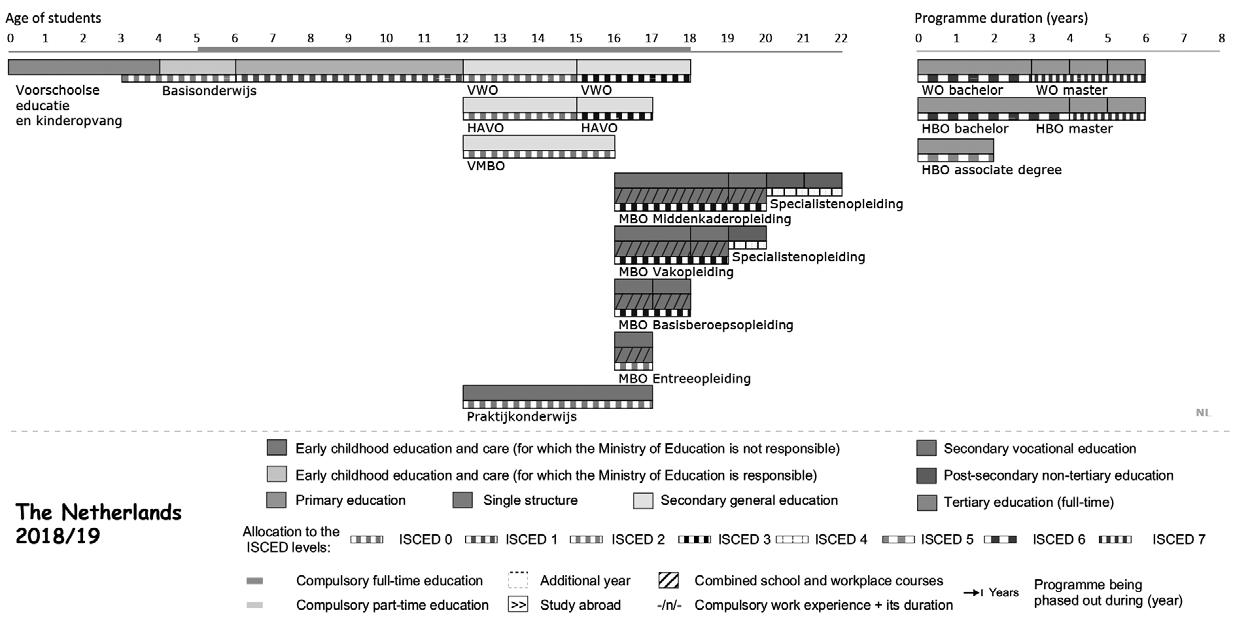
Greece (2016)
Apprenticeship education in its modern form was established in Greece in 1952, and since 1959, the dual system of education and training has also been enshrined in legislation. In its current form, it has been operating since 2006. According to the valid legislation, apprenticeship education is considered as a part of the system of vocational and technical education within secondary education and has the characteristics of the dual system of education and training. The theoretical part of teaching and work in the laboratory is carried out in secondary vocational schools (EPAS), while practical training takes place in the workplace at the employer, which might be from the public or private sector. EPAS needs to be continuously replaced in the framework of vocational seminary (EPAL) by the year of practical training of students for technical vocational education and the SEC (apprenticeship schools / vocational training schools) for vocational education.
The issue of vocational education in Greece is not systematically addressed, there is inconsistency in it, as regards e.g. duration of the training, remuneration criteria, etc. Student can choose from several options for obtaining a professional qualifi cation, EPAS is the option that is closest to Cedefop’s defi nition of dual system of education and training. This form of education is fi nanced mainly from EU resources and resources from the Ministry of Labour. Employers receive subsidies for apprentices. Apprentices receive an allowance that is not taxable and is paid from the resources of the employer and the state.
EPAS is part of the upper secondary education system. These schools can be attended by students aged 16-23, with the condition of admission being the completion of at least the 1st year of high seminary (upper secondary education). Approximately 30% of the total length of education takes place at school and in the workshop and 70% at the workplace, while within one week, students are preparing at school and at the employer with whom they have an apprenticeship contract. The contract is concluded between the school, the student and the employer. In the school year 2014/2015, only 8.2% of all secondary vocational school students were educated in this model.
Vocational training is not popular in Greece and students are interested in general education despite the government’s eff orts to increase the prestige of vocational training.
Figure 14 System of education in Greece (Eurydice 2019 – https://eacea.ec.europa.eu/national-policies/ eurydice/content/greece_en)

Sweden (2016)
Several apprenticeship systems were tested in Sweden. The current one was piloted in 2008–2011 and led to the reform of 2011. Apprenticeship education became an alternative, parallel way to more theoretical education implemented in schools, where there are only 15 weeks of on-the-job training throughout the study period. Since 2015, further reform is being worked on, the aim of which is to make dual education system more attractive among secondary vocational school students and to facilitate the transition of young people from school to work.
There are 4 types of apprenticeships in Sweden - for upper secondary youth aged 16-18/19, for upper secondary students with special educational needs, for adults and adults with special educational needs. Graduates of these programs receive an apprenticeship certifi cate.
Approximately 29% of all secondary school students study in vocational secondary schools, of which approximately 9% study apprenticeships. This is 3% of all high school students. The number of students involved in dual education system is rising.
Within upper secondary education (gymnasial lärlingsutbildning), the practical part of teaching is to take place in one or more workplaces, and needs to represent more than 50% of the total time of the educational program. On-the-job training can begin in the 1st, 2nd or 3rd grade of study at a secondary vocational school, with the standard length of the training program is 3 years. In the case of students with special educational needs, it is 4 years. The student, employer and
school enter into a contractual relationship. The school is responsible for ensuring the conditions (e.g. also for obtaining employers) and the organization of education (including the provision of alternatives).
Dual on-the-job training is funded by the state. The employer receives subsidies and can also apply for a grant. However, it is not his duty to pay the apprentice a salary for the done work, as he has the status of a student. If they nevertheless decide to do, they need to conclude an apprenticeship contract. The state provides a study grant to all high school students. Students can also apply for a travel/housing allowance and lunch.
Figure 15 The system of education in Greece (Eurydice 2019 – https://eacea.ec.europa.eu/national-policies/ eurydice/content/sweden_en)

Bulgaria (2019)
The dual system of education and training in Bulgaria is based on the Swiss model. Legislative adjustments to its introduction were made in 2014 on the basis of the need to prepare the workforce for the real needs of the labour market.
The dual system of education and training is carried out as part of upper secondary education for students who have reached the age of 16 and is defi ned as a specifi c form of education in which professional qualifi cations are obtained through practical on-the-job training and school education. Practical training in the organization is carried out based on an apprenticeship contract between the student and the employer. Practical training can also take place at several employers contracted by the school. There is no upper age limit, but by default, it is for students aged from 16 to 19. The length of curricula within secondary vocational education is 5 years, but on-the-job training is carried out only during the last 2 years of study. During this period, the
time spent at the workplace exceeds 50% of the total training time – in the penultimate year, it is at least 2 days a week, in the last grade at least 3 days a week. On-the-job training can also take place as part of post-secondary education.
All costs related to the practical training of the student at the workplace (including salary) are born by the employer. Apprentices’ health insurance is paid by the state.
Figure 16 The system of education in Bulgaria (Eurydice 2019 – https://eacea.ec.europa.eu/ national-policies/ eurydice/content/bulgaria_en)

Spain (2016)
In Spain, the term dual system of education and training is used and is defi ned as those educational activities or initiatives that combine employment and training to obtain a professional qualifi cation by alternating work activities within an organization (with an employer) and vocational training within the education system or employment offi ce. One of the possibilities is when the dual system of education and training is implemented based on an apprenticeship contract between the student and the employer, where the student has the status of an employee. A cooperation agreement is concluded between the school and the employer.
The dual system of education and training in its current form was enshrined in legislation in 2012 and since then it has been developing intensively in Spain. It represents an alternative to a more theoretical (school) model of vocational education. It is implemented at the secondary and post-secondary level of education. The minimum age of students in the dual system of education and training is 16 years. It is primarily intended for young people aged from 16 to 25, but until the unemployment rate falls below 15%, it can be realized up to the age of 30. On-the-job training needs to represent at least 33% of the total
duration of the program. The duration of the educational program is 1 to 2 years, but it can be extended to 3 years. In the dual system of education and training, approximately 1.3% of all students in secondary vocational education are educated.
At the beginning of vocational education, students complete at least 1 semester at school, without going to the workplace, to acquire basic knowledge in the fi eld of health and safety at least. The form of alternation of periods spent at school and in the workplace is determined by individual autonomous regions.
In Spain, the dual system of education and training is fi nanced partly by the employer, who pays the employee (apprentice) for the hours worked, and partly by the state budget and EU funds. The employer receives relief from the state in fulfi lling the contribution obligation.
Figure 17 The system of education in Spain (Eurydice 2019 – https://eacea.ec.europa.eu/ national-policies/ eurydice/content/spain_en)

Poland (2016)
Apprenticeship education in Poland has a long history, it was established in 1918. The current scheme has been in operation since the 1940s, but only in recent years, it has gained in popularity. Apprenticeships are attractive to students because, unlike the predominantly theoretical model of education, they gain more practical experience and they get paid for the work done. From 1989 to 2012, vocational education was reformed several times, with eff orts being directed towards a greater emphasis on the practical component of education and training in the labour market.
As in most European countries, the dual system of education and training at the upper secondary level in Poland is one of the possible forms
of the vocational training organization. As in Slovakia, it is implemented based on an apprenticeship contract between the student/apprentice and the employer and a contract between the school and the employer.
The dual system of education and training is primarily intended for students aged from 16 to 18. The length of the educational program is in the range of 2–3 years. It is chosen by about 10% of all students after lower secondary education, which is about 60% of all students in secondary vocational schools. They are educated 2 days a week at school and spend the other 3 days at the employer’s workplace – they are students as well as employees. On-the-job training should represent at least 60% (which is 970 hours) of the total training time. The salary of the apprentice is paid by the employer, who is, however, entitled to be funded for the implementation of the dual system of education and training by the state. Compared to other countries, this wage is low, according to the year of study it represents 4%–6% of the average monthly wage in the national economy for the previous quarter. The employer may (but does not have to) contribute to the apprentice e.g. for travel costs, accommodation, etc.
Figure 18 The system of education in Poland (Eurydice 2019 – https://eacea.ec.europa.eu/ national-policies/ eurydice/content/poland_en)
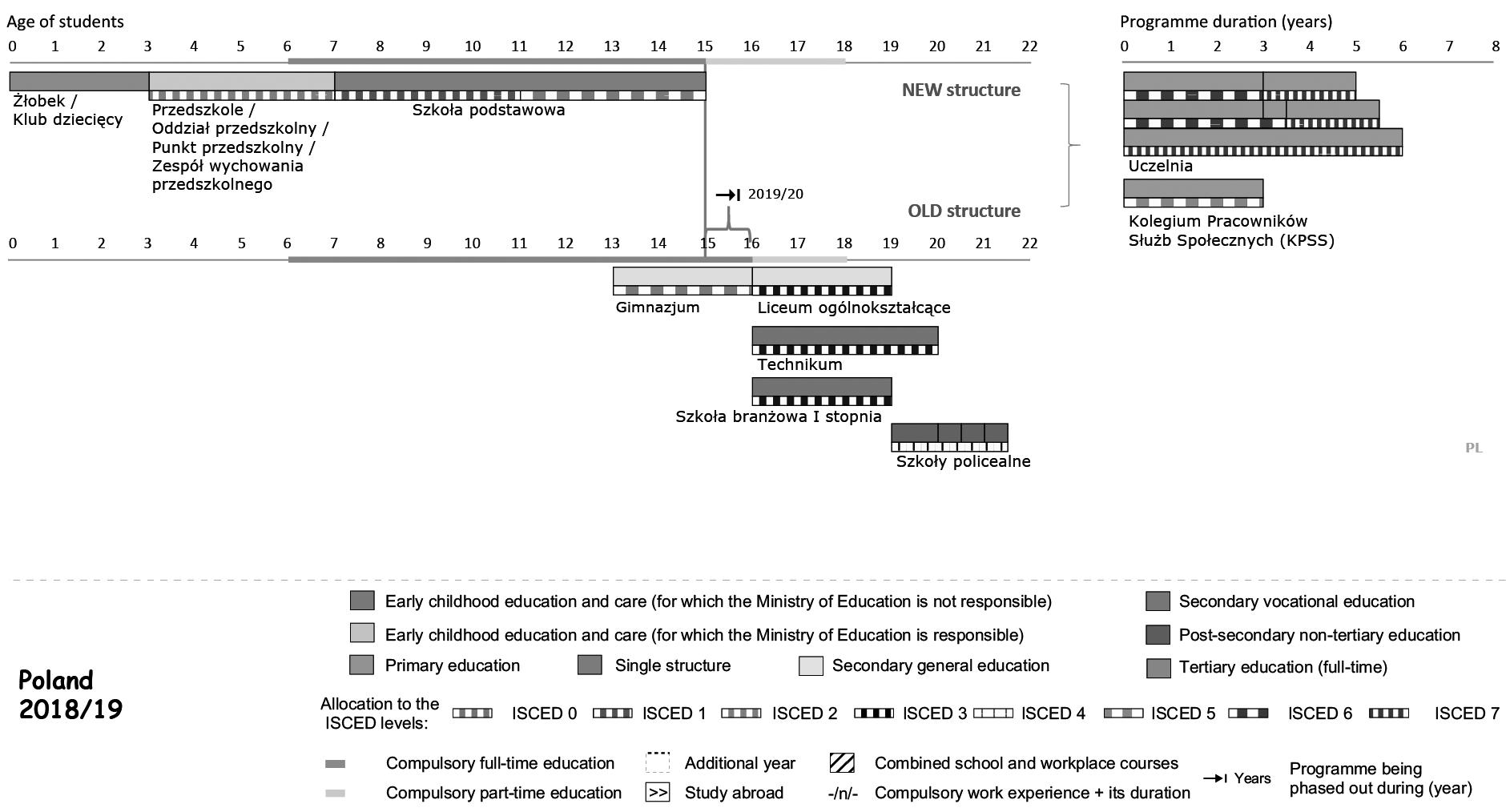
Italy (2016)
Apprenticeship legislation was fi rst introduced in Italy in 1955. Signifi cant reforms took place in 2011 and 2015 to integrate young people into the work environment and increase their chances of fi nding a job.
Unlike other European countries, an apprenticeship contract is concluded as an employment contract between a student and an employer for an indefi nite period to obtain a qualifi cation through a combination of school education and work experience. After completing their training, they can terminate the apprenticeship contract, but if they do not do it, it automatically becomes an employment contract.
The dual system of education and training is used both at the upper secondary level of education, as well as within higher education, with a duration of 3–4 years. At the upper secondary level, it is intended for students aged from 15 to 25. In 2013, only 2.5% of all secondary vocational school students were educated in the dual system of education and training, which is approximately 1.5% of students at the upper secondary level.
Although the form of implementation of alternating school teaching and training in the workplace is not enshrined in legislation, the following schemes apply by default: a. 2 days a week at school and 3 days at work; or b. 1 week at school and 3 weeks at work.
The salary for the done work of the apprentice is paid by the employer, who receives tax relief from the state.
Figure 19 The system of education in Italy (Eurydice 2019 – https://eacea.ec.europa.eu/ national-policies/ eurydice/content/italy_en)
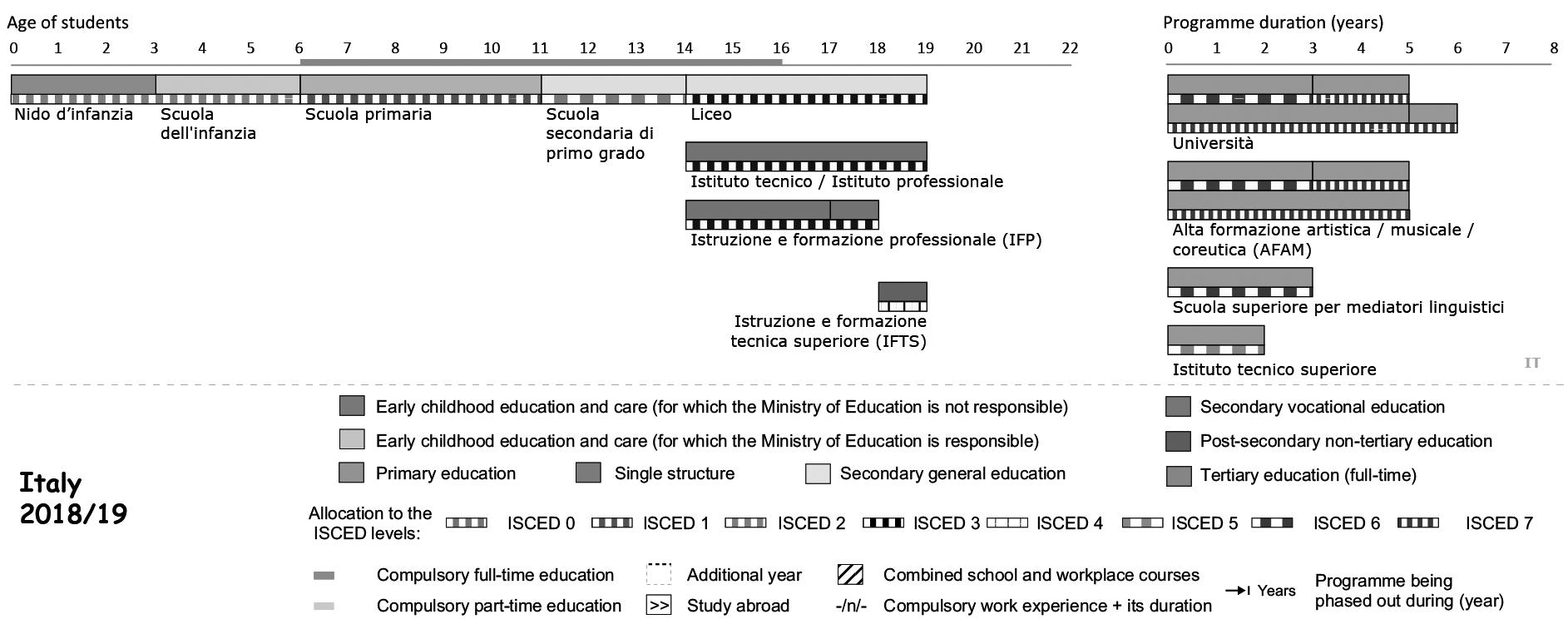
Hungary (2016)
The dual system of education and training in Hungary is regulated by the Vocational Education and Training Act of 2011, which entered into force in 2012, but most schools did not start dual system
of education and training until the 2013/2014 school year. As in Slovakia, in Hungary, it is also possible to obtain secondary vocational education outside the dual system of education and training. As in our conditions, the problem in Hungary is that employers are not interested in participating in the dual system of education and training. E.g. in 2014, it was possible to implement vocational training in a dual system of education and training only in 10 professions.
The dual system of education and training is implemented at the upper level of secondary education and is primarily intended for students aged from 14 to17. The length of the curriculum is 24–36 months. Apprenticeship education ends with a fi nal exam and the graduate receives an apprenticeship certifi cate.
In Hungary, within the dual system of education and training, duties, responsibilities and costs are shared between the state and the participating organizations. Approximately 40% of all Hungarian secondary vocational school students take part in this type of education. Schools and employers jointly participate in the training of apprentices for the profession – schools provide theoretical and employers the practical training of apprentices. The apprentice has the status of a student of the school and at the same time, he is an employee of the company. Vocational training at the workplace makes up 40%–80% of the educational program, the standard is approx. 70% of the total duration. The apprenticeship contract is concluded between the student and the employer. During the duration of the contract, the apprentice is paid a wage by the employer. The employer is provided with tax relief by the state and receives a normative allowance for each apprentice.
Figure 20 The system of education in Hungary (Eurydice 2019 – https://eacea.ec.europa.eu/ national-policies/ eurydice/content/hungary_en)
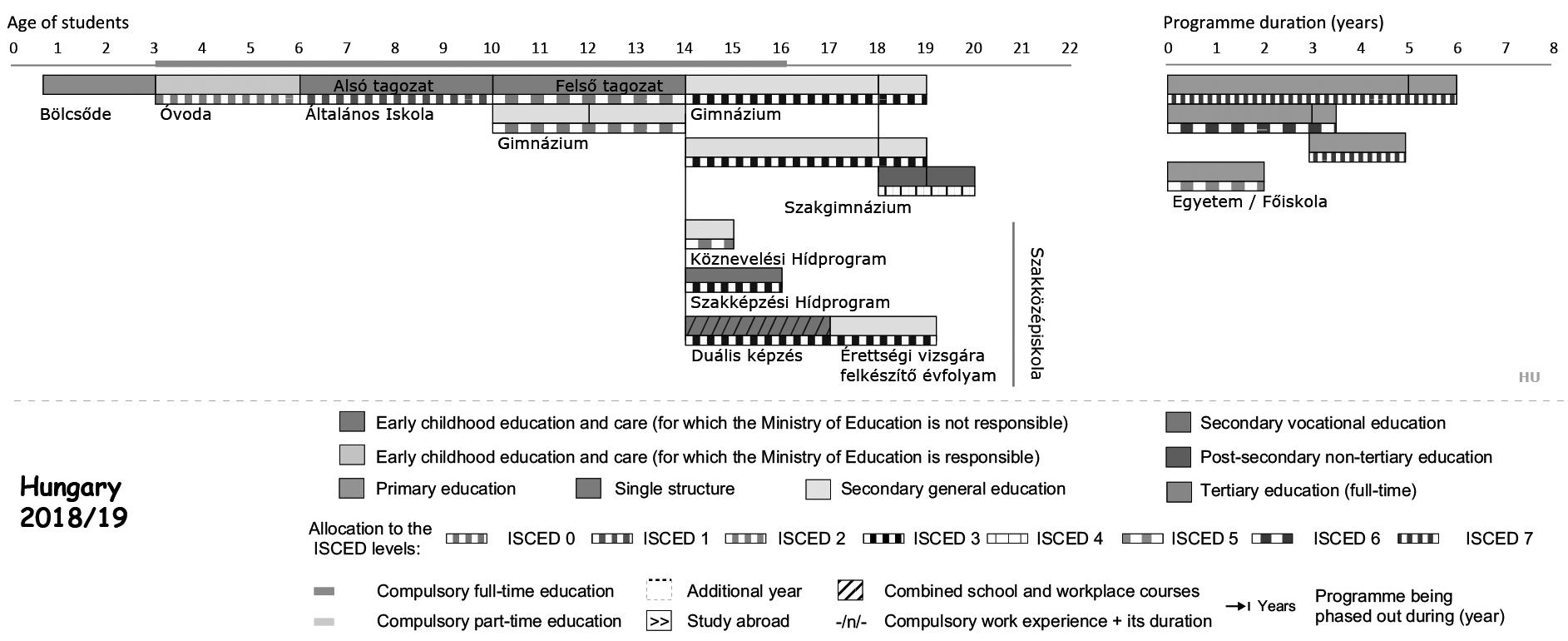
Croatia (2016)
Croatia does not have many years of experience with the dual system of education and training yet. Apprenticeship education was introduced as part of the upper level of secondary education within the so-called Unifi ed model of education in the Croatian school system in the school year 2004/2005 and the length of the curriculum is 3 years. The fi rst attempts at dual education system appeared in 1994, when the law on crafts was adopted, which created a legislative framework leading to changes in the school law as well. Based on it, curricula were developed and conditions were created for this form of study. Since the 1995/1996 school year, dual education system programs have also been introduced, but these have been replaced by others within the Unifi ed Model of Education. Comprehensive curricular reform has been implemented since 2015.
Students enter the dual system of education and training after completing compulsory schooling at the age of 15–16. Applicants need to fi nd an employer who is involved in the dual system of education and training before being admitted to this form of study, with which they then sign an apprenticeship contract. On-the-job training accounts for 40%–50% of the total teaching time, with a week at school alternating with a week at the workplace. Unemployed people can also take part in the dual system of education and training as part of retraining, which means that there is no upper age limit.
Employers who want to participate in the dual system of education and training needs to fi rst demonstrate that they meet the conditions and obtain accreditation. Apprentices are paid a monthly wage for the work done, which is calculated from the average wage in the previous year. The fi rst year is 10%, the second is 20% and the third is 25% of the average wage. Employers are provided with tax relief by employers, special assistance is provided in the case of occupations in which there is a shortage of workers.
In 2016, 36.5% of the population of secondary vocational school students in Croatia were educated in the dual system of education and training, which is 25.9% of all secondary school students.

Figure 21 The system of education in Croatia (Eurydice 2019 – https://eacea.ec.europa.eu/ national-policies/ eurydice/content/croatia_en)
Slovenia (2019)
In Slovenia, pilot testing of apprenticeships at the upper secondary level is currently underway (since 2017). The pilot program will be evaluated in 2021.
Apprenticeship education is an alternative form of obtaining secondary education and its basic precondition is the conclusion of an apprenticeship contract between the student and the employer. Currently, less than 3% of all secondary vocational school students are educated in this form.
Figure 22 The system of education in Slovenia (Eurydice 2019 – https://eacea.ec.europa.eu/ national-policies/ eurydice/content/slovenia_en)

Romania (2016)
Apprenticeship education in Romania has been running for almost 90 years, but elements of dual system of education and training were not introduced into secondary vocational education until 2013. The dual system of education and training has not been fully implemented yet.


